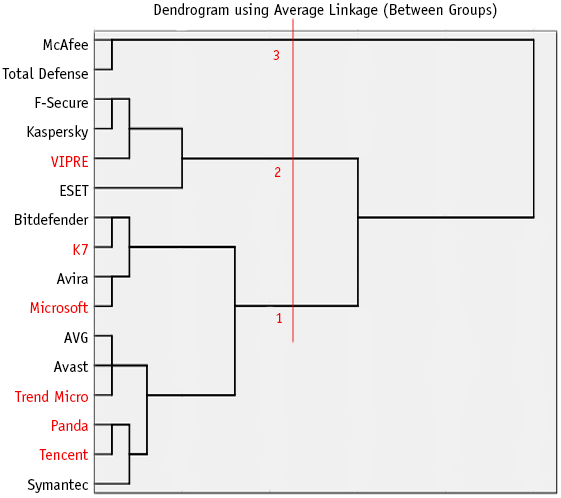
Malware Protection Test September 2019
File Detection Test with Execution including false alarm test
| Release date | 2019-10-15 |
| Revision date | 2019-10-14 |
| Test Period | September 2019 |
| Number of Testcases | 10556 |
| Online with cloud connectivity |  |
| Update allowed |  |
| False Alarm Test included |  |
| Platform/OS | Microsoft Windows |
Introduction
In the Malware Protection Test, malicious files are executed on the system. While in the Real-World Protection Test the vector is the web, in the Malware Protection Test the vectors can be e.g. network drives, USB or cover scenarios where the malware is already on the disk.
Please note that we do not recommend purchasing a product purely on the basis of one individual test or even one type of test. Rather, we would suggest that readers consult also our other recent test reports, and consider factors such as price, ease of use, compatibility and support. Installing a free trial version allows a program to be tested in everyday use before purchase.
In principle, home-user Internet security suites are included in this test. However, some vendors asked us to include their (free) antivirus security product instead.
Tested Products
Information about additional third-party engines/signatures used inside the products: Tencent (English version), Total Defense and VIPRE use the Bitdefender engine. F-Secure uses the AVIRA engine. AVG is a rebranded version of Avast.
All products were installed on a fully up-to-date 64-Bit Microsoft Windows 10 Pro 1903 system. Products were tested at the beginning of September with default settings and using their latest updates.
Test Procedure
The Malware Protection Test assesses a security program’s ability to protect a system against infection by malicious files before, during or after execution. The methodology used for each product tested is as follows. Prior to execution, all the test samples are subjected to on-access and on-demand scans by the security program, with each of these being done both offline and online. Any samples that have not been detected by any of these scans are then executed on the test system, with Internet/cloud access available, to allow e.g. behavioral detection features to come into play. If a product does not prevent or reverse all the changes made by a particular malware sample within a given time period, that test case is considered to be a miss. If the user is asked to decide whether a malware sample should be allowed to run, and in the case of the worst user decision system changes are observed, the test case is rated as “user-dependent”.
Detection vs. Protection
The File Detection Test we performed in previous years was a detection-only test. That is to say, it only tested the ability of security programs to detect a malicious program file before execution. This ability remains an important feature of an antivirus product, and is essential for anyone who e.g. wants to check that a file is harmless before forwarding it to friends, family or colleagues.
This Malware Protection Test checks not only the detection rates, but also the protection capabilities, i.e. the ability to prevent a malicious program from actually making any changes to the system. In some cases, an antivirus program may not recognise a malware sample when it is inactive, but will recognise it when it is running. Additionally, a number of AV products use behavioural detection to look for, and block, attempts by a program to carry out system changes typical of malware. Our Malware Protection Test measures the overall ability of security products to protect the system against malicious programs, whether before, during or after execution. It complements our Real-World Protection Test, which sources its malware samples from live URLs, allowing features such as URL blockers to come into play. Both tests include execution of any malware not detected by other features, thus allowing “last line of defence” features to come into play.
One of the significances of cloud detection mechanisms is this: Malware authors are constantly searching for new methods to bypass detection and security mechanisms. Using cloud detection enables vendors to detect and classify suspicious files in real-time to protect the user against currently unknown malware. Keeping some parts of the protection technology in the cloud prevents malware authors from adapting quickly to new detection rules.
Testcases
The test set used for this test consisted of 10,556 malware samples, assembled after consulting telemetry data with the aim of including recent, prevalent samples that are endangering users in the field. Malware variants were clustered, in order to build a more representative test-set (i.e. to avoid over-representation of the very same malware in the set). The sample collection process was stopped on the 30th August 2019.
Ranking System
Hierarchical Cluster Analysis
This dendrogram shows the results of the cluster analysis over the online protection rates. It indicates at what level of similarity the clusters are joined. The red drafted line defines the level of similarity. Each intersection indicates a group.
For more information about cluster analysis, see this easy-to-understand tutorial: http://strata.uga.edu/software/pdf/clusterTutorial.pdf
The malware protection rates are grouped by the testers after looking at the clusters built with the hierarchal clustering method. However, the testers do not stick rigidly to this in cases where it would not make sense. For example, in a scenario where all products achieve low protection rates, the highest-scoring ones will not necessarily receive the highest possible award.
(given by the testers after consulting statistical methods) |
||||
| Very few (0-1 FPs) Few (2-10 FP's) | ||||
| Many (11-50 FPs) | ||||
| Very many (51-100 FPs) | ||||
| Remarkably many (over 100 FPs) | ||||
Offline vs. Online Detection Rates
Many of the products in the test make use of cloud technologies, such as reputation services or cloud-based signatures, which are only reachable if there is an active Internet connection. By performing on-demand and on-access scans both offline and online, the test gives an indication of how cloud-dependent each product is, and consequently how well it protects the system when an Internet connection is not available. We would suggest that vendors of highly cloud-dependent products should warn users appropriately in the event that the connectivity to the cloud is lost, as this may considerably affect the protection provided. While in our test we check whether the cloud services of the respective security vendors are reachable, users should be aware that merely being online does not necessarily mean that their product’s cloud service is reachable/working properly.
For readers’ information and due to frequent requests from magazines and analysts, we also indicate how many of the samples were detected by each security program in the offline and online detection scans.
| OFFLINE Detection Rate |
ONLINE Detection Rate |
ONLINE Protection Rate |
False Alarms |
|
|---|---|---|---|---|
| Avast | 97.4% | 99.3% | 100% | 7 |
| AVG | 97.4% | 99.3% | 100% | 7 |
| Avira | 91.4% | 99.5% | 99.96% | 1 |
| Bitdefender | 96.3% | 96.3% | 99.95% | 7 |
| ESET | 98.3% | 98.3% | 99.88% | 0 |
| F-Secure | 91.4% | 97.3% | 99.91% | 4 |
| K7 | 97.2% | 97.2% | 99.95% | 30 |
| Kaspersky | 96.0% | 97.1% | 99.91% | 0 |
| McAfee | 57.6% | 92.2% | 99.82% | 2 |
| Microsoft | 29.7% | 76.3% | 99.96% | 13 |
| Panda | 28.6% | 89.7% | 99.99% | 21 |
| Symantec | 70.5% | 99.5% | 99.98% | 7 |
| Tencent | 96.3% | 96.3% | 99.99% | 27 |
| Total Defense | 96.1% | 96.1% | 99.82% | 3 |
| Trend Micro | 20.9% | 97.9% | 100% | 14 |
| VIPRE | 96.2% | 96.2% | 99.90% | 40 |
Test Results
Total Online Protection Rates (clustered in groups):
Please consider also the false alarm rates when looking at the protection rates below.
| Blocked | User dependent | Compromised | Protection Rate [Blocked % + (User dependent % / 2)] | Cluster | |
|---|---|---|---|---|---|
| Avast | 10556 | - | - | 100% | 1 |
| AVG | 10556 | - | - | 100% | 1 |
| Trend Micro | 10556 | - | - | 100% | 1 |
| Panda | 10555 | - | 1 | 99.99% | 1 |
| Tencent | 10555 | - | 1 | 99.99% | 1 |
| Symantec | 10554 | 2 | - | 99.99% | 1 |
| Avira | 10552 | - | 4 | 99.96% | 1 |
| Microsoft | 10552 | - | 4 | 99.96% | 1 |
| Bitdefender | 10551 | - | 5 | 99.95% | 1 |
| K7 | 10551 | - | 5 | 99.95% | 1 |
| F-Secure | 10547 | - | 9 | 99.91% | 2 |
| Kaspersky | 10547 | - | 9 | 99.91% | 2 |
| VIPRE | 10546 | - | 10 | 99.91% | 2 |
| ESET | 10544 | - | 12 | 99.89% | 2 |
| McAfee | 10537 | - | 19 | 99.82% | 3 |
| Total Defense | 10537 | - | 19 | 99.82% | 3 |
The test-set used contained 10556 recent/prevalent samples from last few weeks.
False Positive (False Alarm) Test Result
In order to better evaluate the quality of the file detection capabilities (ability to distinguish good files from malicious files) of anti-virus products, we provide a false alarm test. False alarms can sometimes cause as much trouble as a real infection. Please consider the false alarm rate when looking at the detection rates, as a product which is prone to false alarms may achieve higher detection rates more easily. In this test, a set of clean files is scanned, and a representative subpart of the clean-set is executed (as done with malware).
| 1. | ESET, Kaspersky | 0 | no/very few FPs | |
| 2. | Avira | 1 | ||
| 3. | McAfee | 2 | few FPs | |
| 4. | Total Defense | 3 | ||
| 5. | F-Secure | 4 | ||
| 6. | Avast, AVG, Bitdefender, Symantec | 7 | ||
| 7. | Microsoft | 13 | many FPs | |
| 8. | Trend Micro | 14 | ||
| 9. | Panda | 21 | ||
| 10. | Tencent | 27 | ||
| 11. | K7 | 30 | ||
| 12. | VIPRE | 40 | ||
Details about the discovered false alarms (including their assumed prevalence) can be seen in the False Alarm Test September 2019.
A product that is successful at detecting a high percentage of malicious files but suffers from false alarms may not be necessarily better than a product which detects fewer malicious files, but which generates fewer false alarms.
Award levels reached in this Malware Protection Test
AV-Comparatives provides ranking awards, which are based on levels of false positives as well as protection rates. As this report also contains the raw detection rates and not only the awards, expert users who may be less concerned about false alarms can of course rely on the protection rate alone. Details of how the awards are given can be found on page 8 of this report.
* these products got lower awards due to false alarms
Copyright and Disclaimer
This publication is Copyright © 2019 by AV-Comparatives ®. Any use of the results, etc. in whole or in part, is ONLY permitted after the explicit written agreement of the management board of AV-Comparatives prior to any publication. AV-Comparatives and its testers cannot be held liable for any damage or loss, which might occur as result of, or in connection with, the use of the information provided in this paper. We take every possible care to ensure the correctness of the basic data, but a liability for the correctness of the test results cannot be taken by any representative of AV-Comparatives. We do not give any guarantee of the correctness, completeness, or suitability for a specific purpose of any of the information/content provided at any given time. No one else involved in creating, producing or delivering test results shall be liable for any indirect, special or consequential damage, or loss of profits, arising out of, or related to, the use or inability to use, the services provided by the website, test documents or any related data.
For more information about AV-Comparatives and the testing methodologies, please visit our website.
AV-Comparatives
(October 2019)
























